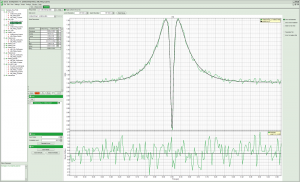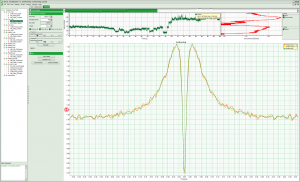Software
QuCoa
Quantum Correlation Analysis Software
- Antibunching (g(2)) measurements including fitting of several models
- Coincidence counting / event filtering using AND, OR, NOT operators
- Preview of antibunching curve and correlation data during measurement
- Remote control via TCP/IP Interface
- Calculation of TCSPC histograms and intensity time traces
- Export of all results to ASCII or images
- User programming script language "STUPSLANG"
The QuCoa software package is an integrated solution for data acquisition and analysis using PicoQuant's TCSPC electronics. It is mainly targeted at research areas that rely on coincidence detection such as Hanbury-Brown-Twiss setups to study single photon sources (g(2) / antibunching), quantum key distributions (QKD), or the study of entanglement using Hong-Ou Mandel setups, to name only a few.
The software is designed for a 64 bit operating system and features an intuitive graphical user interface (GUI). Its clearly structured layout and powerful analysis routines allows focusing on results rather than on data processing. Data dependencies are directly visible thanks to the underlying workspace concept.
Data acquisition with PicoQuant TCSPC modules
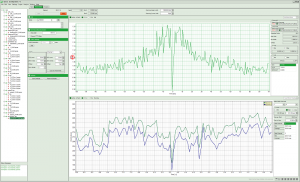 The QuCoa software is based on the unique T2 time-tagged time-resolved data acquisition mode of PicoQuant‘s TCSPC electronics (MultiHarp 150, MultiHarp 160, TimeHarp 260, PicoHarp 330). In this mode, photons on each detection channel are tagged with the absolute arrival time since the beginning of the measurement. This scheme preserves all photon timing information and allows a broad range of data interpretation, ranging from simple intensity time traces to complex correlation and coincidence counting applications.
The QuCoa software is based on the unique T2 time-tagged time-resolved data acquisition mode of PicoQuant‘s TCSPC electronics (MultiHarp 150, MultiHarp 160, TimeHarp 260, PicoHarp 330). In this mode, photons on each detection channel are tagged with the absolute arrival time since the beginning of the measurement. This scheme preserves all photon timing information and allows a broad range of data interpretation, ranging from simple intensity time traces to complex correlation and coincidence counting applications.
Antibunching with cw or pulsed excitation
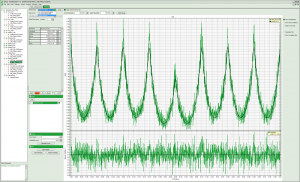 The QuCoa software package includes one of the fastest software correlators on the market, which permits correlating the absolute arrival times of photons in real time to, e.g., asses the quality of an antibunching curve during the measurement. The g(2)(0) value as well as count rates on all detectors are always displayed. Both pulsed and cw excitation modes are supported.
The QuCoa software package includes one of the fastest software correlators on the market, which permits correlating the absolute arrival times of photons in real time to, e.g., asses the quality of an antibunching curve during the measurement. The g(2)(0) value as well as count rates on all detectors are always displayed. Both pulsed and cw excitation modes are supported.
Several established models can be fitted to measured data, including the model of single emitter with or without shelved state or pulsed excitation based on exponential decays. The influence of the limited detector resolution as well as correlated and uncorrelated background can also be included in the fitting. Global fitting is supported for all models.
Coincidence counting
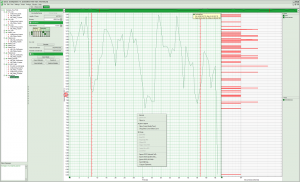 The QuCoa software also includes event filters for coincidence counting applications. Filters can be constructed via an easy to use graphical interface and permits combining detection channels and marker signals in a user-defined time window using logical operations (AND, OR, NOT). The filters can be applied during data acquisition as well as offline. Time gates allow restricting coincidence detection to user-defined time ranges.
The QuCoa software also includes event filters for coincidence counting applications. Filters can be constructed via an easy to use graphical interface and permits combining detection channels and marker signals in a user-defined time window using logical operations (AND, OR, NOT). The filters can be applied during data acquisition as well as offline. Time gates allow restricting coincidence detection to user-defined time ranges.
Integrated scripting language and remote control
The QuCoa software includes an integrated scripting language ("STUPSLANG") that eanbles users to create new analysis procedures or customize existing ones. The QuCoa software can also be remotely controlled via a dedicated TCP/IP protocol.
Current software version: 1.5
This new versions also supports the HydraHarp 500 for data acquisition. Note: the software is protected by a USB dongle and will not work without it.
| Data acquisition | |||
|---|---|---|---|
| Supported TCSPC modules | HydraHarp 400, PicoHarp 330, PicoHarp 300, TimeHarp 260, MultiHarp 150, MultiHarp 160 | ||
| Supported number of detectors | up to 65 (dependent on the number of channels from the TCSPC module) | ||
| Supported number of markers for coincidence counting | up to 4 | ||
| Measurement modes | Antibunching, Coincidence correlation, Coincidence counting | ||
| Measurement previews | Coincidence correlation trace (g(2) / Antibunching), Coincidence counting, Intensity time trace, TCSPC histogram Parallel calculation and display of up to 4 different previews |
||
| Data analysis | |||
| General features | Time gating Binning Least–Squares Fitting, Bootstrap error analysis GUI themes |
||
| Coincidence correlation | Antibunching correlation (g(2)) Antibunching fitting (models: single photon emitter with and without shelving state, pulsed excitation) incl. treatment of limited detector resolution, User-defined models via scripting, Bootstrap error analysis |
||
| Coincidence counting | Combination of detection channels and markers using logical filters (AND, OR, NOT) in user-defined time gates | ||
| Export data formats | BMP, ASCII, TIFF, binary | ||
| User scripting (STUPSLANG) | User-defined analysis procedures | ||
| Remote control | via TCP/IP protocol | ||
| Required PC CPU | with SSE2 and EMT64 or AMD64 extension; recommended: quad–core or better | ||
| CPU clock | minimum 2.2 GHz; recommended: >= 3 GHz | ||
| RAM | minimum 4 GB; recommended: >= 16 GB | ||
| Operating system | Windows 10 x64, Windows 11 x64 | ||
| Disk space | >= 100 MB (except data storage) | ||
| Display(s) | with single display: Full HD; with dual display: 2 × 1680 × 1050 or better; No hiDPI | ||
| Protection module (HASP) | USB | ||
All Information given here is reliable to our best knowledge. However, no responsibility is assumed for possible inaccuracies or omissions. Specifications and external appearances are subject to change without notice.
The quantum correlation analysis software QuCoa can be used in applications where the correlation between single photon events plays a major role, such as:
- Photon Antibunching
- Coincidence Correlation
- Quantum Communication
- Quantum Entanglement
- Quantum Teleportation
- Quantum Information Processing
- Single Photon Sources
The following documents are available for download:



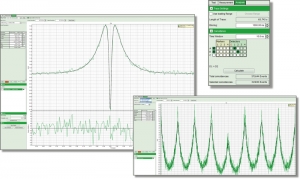
 Contact us
Contact us